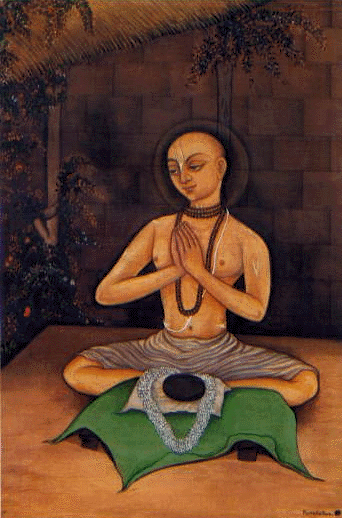
Introduction
by Shrila Gopala Bhatta Gosvami
The meaning of sannyasa is mentioned in Uttara Gita:
nityam naimittikam kamyam
karma trividham ucyate
sannyasah karmanam nyaso
nyasi tad dharmam acaran
“There are three kinds of activities, namely nitya, naimittika and kamya. Giving up all such activities is called nyasa, renunciation, and one who practices renunciation is called as sannyasi.”
Experts in karma understand there are three kinds of activities. Not to perform them is sannyasa and one who does so is called sannyasi. What then is the difference from ‘tyaga’, giving up the results of all such activities?
One should understand that simply by performing the nitya-karma even without desire to get the result, one certainly gets a result. According to the statement of Shruti, ‘athaharah sandhyam upasita’, one should perform sandhya rites everyday. That activity is done with the aim to remove accidental sins. Though one may not desire those results, the result will still come.
As stated in Harita-samhita:
pratyam yas tri-kalajnah
sandhyopasana-krid dvijah
brahma-lokam avapnoti
gayatri-japa-tat-parah
“The twice born (dvija) who engages in japa or chanting the gayatri mantra daily at the three sandhyas attains the planet of Brahma.”
‘Dvija’ means brahmana, kshatriya, and vaishya. ‘Tri-kala-jna’ means the knower of the three junctures of the day — morning, noon and evening. ‘Gayatri-japa-tatparah’ means he is seriously engaged in gayatri japa, at the time of sandhya. He naturally attains Brahmaloka after he quits his body, even though he has no desire to enjoy the result of his work.
Also in the naimittika-karmas (such as offering pindas to the ancestors) one gets the result of his work even without having any desire for the results . As stated in Skanda Purana:
gayayam viraje caiva
mahendre janavitate
atra pinda-prado yati
brahma-lokam anamayam
“One who offers pinda, or food, to his forefathers in Gaya, in the region of Viraja, on the hill called Mahendra on the bank of Jahnavi (Ganga), attains the planet of Brahma which is free from diseases.”
‘Gaya’ refers to the lotus feet of Lord Vishnu and for an area of two miles (kosha) around or according to the Puranas, four, eight and sixteen miles around. ‘Ca’ means Kurukshetra, Badrinath, Kedaranath, Venkatacala, Shri Ranganath kshetra, Shri Purushottama kshetra and other pilgrimage places. In the same way, the word ‘Jahnavi-tate’ refers to any place within a distance of two miles from the Ganges. In these places, one who offers pinda, performing shraddha to his forefathers, certainly accomplishes his desires and attains Brahmaloka. Similarly, his sons and grandsons who offer pindas also attain anamaya, or the place which is free from all kinds of disturbances—the three kinds of miseries, disease and lamentation, for half the lifetime of Lord Brahma (dviparadha).
Kamya karmas are specifically performed to fulfill some desire, but result is there even if one performs them without any desire. As stated in Brihad Vishnu Purana:
yah kashcid purusho’ piha
kritva candrayanam vratam
mucyate sarva-papebhyas
tatha dvadasha varshikam
“Any one in this world can be free from all kinds of sinful reactions by performing atonement and the twelve year penance.”
In this world, any person even outside the varnashrama system, who performs candrayana or atonement and twelve years austerity according to his wealth, without desiring the result, becomes free from all kinds of sinful reactions, namely pataka, maha pataka, atipataka, and anupataka. One becomes freed not only from suffering in the hellish planets as a result of sinful reactions, but becomes freed of material bondage.
Therefore it is said that sannyasa is to give up completely nitya, naimittika, and kamya activities, whereas ‘tyaga’ is to perform all those activities but giving up the fruits. There should be no confusion about this.
Leave a Reply